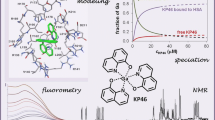Abstract
Cobalt–alkyne complexes are a new class of potent cytotoxic drugs. The lead compound [2-acetoxy-(2-propynyl)benzoate]hexacarbonyldicobalt (Co-ASS) showed high effects on several human cancer cell lines. In order to evaluate further the in-vitro properties and reactivity of this substance we performed stability and protein binding studies and investigated the interaction of this complex with 1,2-ethanedithiol, L-cysteine and glutathione. UV–Vis, HPLC and AAS studies showed that the compound was sufficiently stable under in-vitro conditions. Binding to human serum albumin increased from approximately 25% at the beginning to over 50% after 48 h of incubation as determined by ethanol preciptation and size exclusion chromatography. The interaction with thiols resulted in disulfide bond formation of the thiols.
Similar content being viewed by others
References
RD Adams JA Queisser JH Yamamoto (1996) ArticleTitleCatalytic transformations of thiiranes by the W(CO)5 grouping A new rote to cyclic polydisulfides. J Am Chem Soc 118 10674–10675
A Amann C Decristoforo I Ott et al. (2001) ArticleTitleSurfactant protein B labelled with [99mTc(CO)3(H2O)3]+retains biological activity in vitro Nucl Med Biol 28 243–250
JB Arterburn MC Perry SL Nelson et al. (1997) ArticleTitleRhenium-catalyzed oxidation of thiols and disulfides with sulfoxides J Am Chem Soc 119 9309–9310
G Bernhardt M Koch T Spruss et al. (1999) ArticleTitle[Meso-1,2-bis(2,6-dichloro-4-hydroxyphenyl)ethylenediamine]sulfatoplatinum (II)- Pharmacokinetic studies Arch Pharm Pharm Med Chem 332 195–200
T Boulikas M Vougiouka (2003) ArticleTitleCisplatin and platinum drugs at the molecular level (review) Oncol Rep 10 1663–1682
MM Bradford (1976) ArticleTitleA rapid and sensitive method for the quantitation of microgram quantities of protein utilizing the principle of protein-dye binding Anal Biochem 72 248–254 Occurrence Handle10.1006/abio.1976.9999 Occurrence Handle1:CAS:528:DyaE28XksVehtrY%3D Occurrence Handle942051
CdS Ferreira PS Martins C Demicheli et al. (2003) ArticleTitleThiol induced reduction of antimony(V) into antimony(III): a comparative study with tryptanothione, cysteinyl-glycine, cysteine and glutathione Biometals 16 441–446
AI Ivanov J Christodoulou JA Parkinson et al. (1998) ArticleTitleCisplatin binding sites on human albumin J Biol Chem 273 IssueID24 14721–14730
M Jung DE Kerr PD Senter (1997) ArticleTitleBioorganometallic chemistry–synthesis and antitumor activity of cobalt carbonyl complexes Arch Pharm Pharm Med Chem 330 173–176
S Leonard PM Gannett Y Rojanasakul et al. (1998) ArticleTitleCobalt-mediated generation of reactive oxygen species and its possible mechanism J Inorg Biochem 70 239–244
RF Lockwood KM Nicholas (1977) ArticleTitleTransition metal-stabilized carbenium ions as synthetic intermediates I. α -[(alkynyl)dicobalt hexacarbonyl] carbenium ions as propargylating agents. Tetrahedron Lett 48 4163–4166
J Ma G Stoter J Verweij JHM Schellens (1996) ArticleTitleComparison of ethanol plasma-protein precipitation with plasma ultrafiltration and trichloroacetic acid protein precipitation for the measurement of unbound platinum concentrations Cancer Chemother Pharmacol 38 391–394
N Metzler-Nolte (2001) ArticleTitleLabeling of biomolecules for medicinal applications–bioorganometallic chemistry at its best Angew Chem Int Ed Engl 40 IssueID6 1040–1043
C Neumann Boubakari R. Gruenert et al. (2003) ArticleTitleNicotinamide adenine dinucleotide phosphate-regenerating system coupled to a glutathione-reductase microtiter method for determination of total glutathione concentrations in adherent growing cancer cell lines Anal Biochem 320 170–178
D Osella J Fiedler (1992) ArticleTitleReinvestigation of the electrochemical behavior of the Co2(CO)6(ethynylestradiol) complex Evidence of efficient recombination of the electrogenerated fragments Organometallics 11 3875–3878
D Osella G Jaouen P Zanello (1991) ArticleTitleTransition metal complexes as electrochemical markers for steroids Organomet Chem 401 IssueID1–2 37–47
I Ott B Kircher R Gust (2004) ArticleTitleInvestigations on the effects of cobalt–alkyne complexes on leukemia and lymphoma cells: cytotoxicity and cellular uptake J Inorg Biochem 98 485–489
PL Pauson (1985) ArticleTitleThe Khand reaction Tetrahedron 41 IssueID24 5855–5860
M Perquin T Oster A Maul et al. (2001) ArticleTitleThe glutathione-related detoxification system is increased in human breast cancer in correlation with clinical and histopathological features J Cancer Res Clin Oncol 127 368–374
T Roth C Eckert HH Fiebig et al. (2002) ArticleTitleComparative action of cobalt carbonyl complexes on cancer cells using human tumor xenografts Anticancer Res 22 2281–2284
S Schertl RW Hartmann C Batzl-Hartmann et al. (2004) ArticleTitle[1,2-Bis(2,6-difluoro-3-hydroxyphenyl)ethylenediamine]platinum (II) complexes, compounds for the endocrine therapy of breast cancer–mode of action II: contribution of drug inactivation, cellular drug uptake and sterical factors in the drug–target interaction to the antitumor activity Arch Pharm Pharm Med Chem 337 349–359
K Schmidt M Jung R Keilitz et al. (2000) ArticleTitleAcetylenehexa carbonyldicobalt complexes, a novel class of antitumor drugs Inorg Chim Acta 306 6–16
X Verdaguer A Moyano MA Pericas et al. (1999) ArticleTitleAlkyne dicobalt carbonyl complexes with sulfide ligands Synthesis, crystal structure, and dynamic behavior. Organometallics 18 4275–4285
A Vessieres S Top C Vaillant et al. (1992) ArticleTitleEstradiols modified by metal carbonyl clusters as suicide substrates for the study of receptor proteins: application to the estradiol receptor Angew Chem Int Ed Engl 31 754–755
Author information
Authors and Affiliations
Corresponding author
Additional information
Published online: March 2005
Rights and permissions
About this article
Cite this article
Ott, I., Gust, R. Stability, protein binding and thiol interaction studies on [2-acetoxy-(2-propynyl)benzoate]hexacarbonyldicobalt. Biometals 18, 171–177 (2005). https://doi.org/10.1007/s10534-004-6252-z
Received:
Accepted:
Issue Date:
DOI: https://doi.org/10.1007/s10534-004-6252-z




